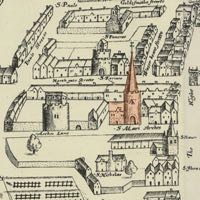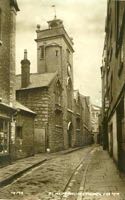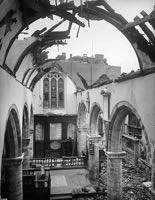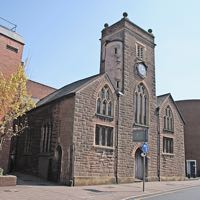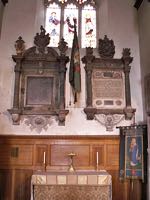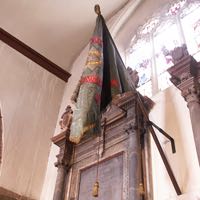
 St Mary Arches Church - Mary Arches Street
St Mary Arches Church - Mary Arches Street
Page updated 28th May 2018
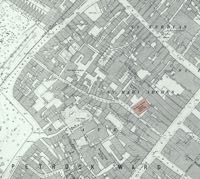 Situated just off the top of Fore Street in what
was a narrow alleyway and is now an important part of the one-way
system, this little church, whose origins are probably Celtic, has some important Norman architectural features. It
retains its Norman windows and the arches lining each side of the nave,
separating it from the side aisles.
Situated just off the top of Fore Street in what
was a narrow alleyway and is now an important part of the one-way
system, this little church, whose origins are probably Celtic, has some important Norman architectural features. It
retains its Norman windows and the arches lining each side of the nave,
separating it from the side aisles.
The earliest record of the church is when it was included in the will of Peter de Palerna, in the reign of King John. During the 14th to 16th centuries, it was used as a centre of worship by many merchants and Mayors of Exeter, and memorials and tombs of some are still evident. There are up to eight City Magistrates buried within the precincts of the church.
In 1636, the Puritans ordered the number of churches in the city be reduced to four–St Mary Arches' being one of the four survived, but it would seem its stained glass was removed. Having been deprived of its ancient glass, there is a record in 1641 of funds collected "for the new glazing ye church windows in Mary Arches parish where ye olde painted glass had been taken down by a late order from ye House of Commons in Parliament."
The interior
The interior is of a nave, with north and south aisles, and a chancel approached with shallow steps from the nave. An important feature of the church is the Norman arches of the nave, from which it is name. There are four bays on each side, with plain circular columns of late Norman style, and square capitals decorated with scollop moulding, and traces of chevron ornament on the edge of the abacus. They date from the end of the 11th or early 12th Century.
The church has evidence of its connection with commerce with a gravestone that has a commerce mark carved into it, and the tomb of Thomas Andrew being adorned with the arms of the Merchant Adventurers., these having a "nebuly (wavy edge of a cloud) of six on a chief quarterly 1st and 4th of a lion of England, 2nd and 3rd two roses."
In September 1739, John Wesley was offered the chance to preach from the church by Robert Wight, Prebendery. Edith Cresswell wrote:
"John Wesley visited Exeter, and St. Mary Arches was lent to him for the morning and evening service. But his sermon in the morning displeased the Rector, who withdrew his consent to Wesley's preaching again, one of his objections being that though Mr. Wesley's doctrine was of the Church of England, it was dangerous, and might lead people into enthusiasm."
When the public conduit situated outside the College of the Vicars Choral in South Street was demolished in 1830, the four decorative stone balls on the top were relocated onto the four corners of the tower of St Mary Arches, where they remain to this day.
A couple of personalities
In 1918, a former St David's School pupil, and St Mary Arches' choir boy, Gunner William Ford was awarded the DCM for gallantry. Mr. Reginald J. Woodland, of Howell Road, passed the Association Examination of the Royal College of Organists at the age of 26. He had been appointed organist at the church at the age of 15. He acquired a high reputation, and had taken the church's choir to Wells Cathedral in 1931.
The church celebrated the 800th Anniversary of its founding in June 1930, three years before the Cathedral was founded.
Almost destroyed
The church escaped the actual bombing of 4th May 1942. However, while the sisters of St Wilfrid's Community held a communion service on the next day, a smouldering incendiary bomb erupted. The sisters had to dash into the church to save the processional cross and crucifix. The 15th-century wagon roof was badly damaged and much original furniture was lost.
By 1950, the church had been restored by S Dykes-Bower. On Sunday 8 May, the church was rededicated by The Rt Rev Surtees, Bishop of Crediton, with a large number of parishioners in attendance. The roof, was rebuilt as a barrel vault, using oak and red pine timbers from the US timber store at the Topsham Naval Store that had been held back to repair landing craft damaged during D-Day. The baulks of timber were 16ft long, 11 inches wide and 4 inches tick. One oft repeated, and incorrect, story goes that they used timber from a beached landing craft that took part in the D-day landings. The outside was not so well restored and imitation stone was used to make repairs.
The church is now the home of the colours of Devon's Home Guard, or 'Dad's Army' and those men who died defending Devon during the air-raids. See Home Guard Graves
Sources: Western Morning News (9 May 1950), 2000 Years in Exeter by W G Hoskins. Exeter Churches by Edith Cresswell.
│ Top of Page │
